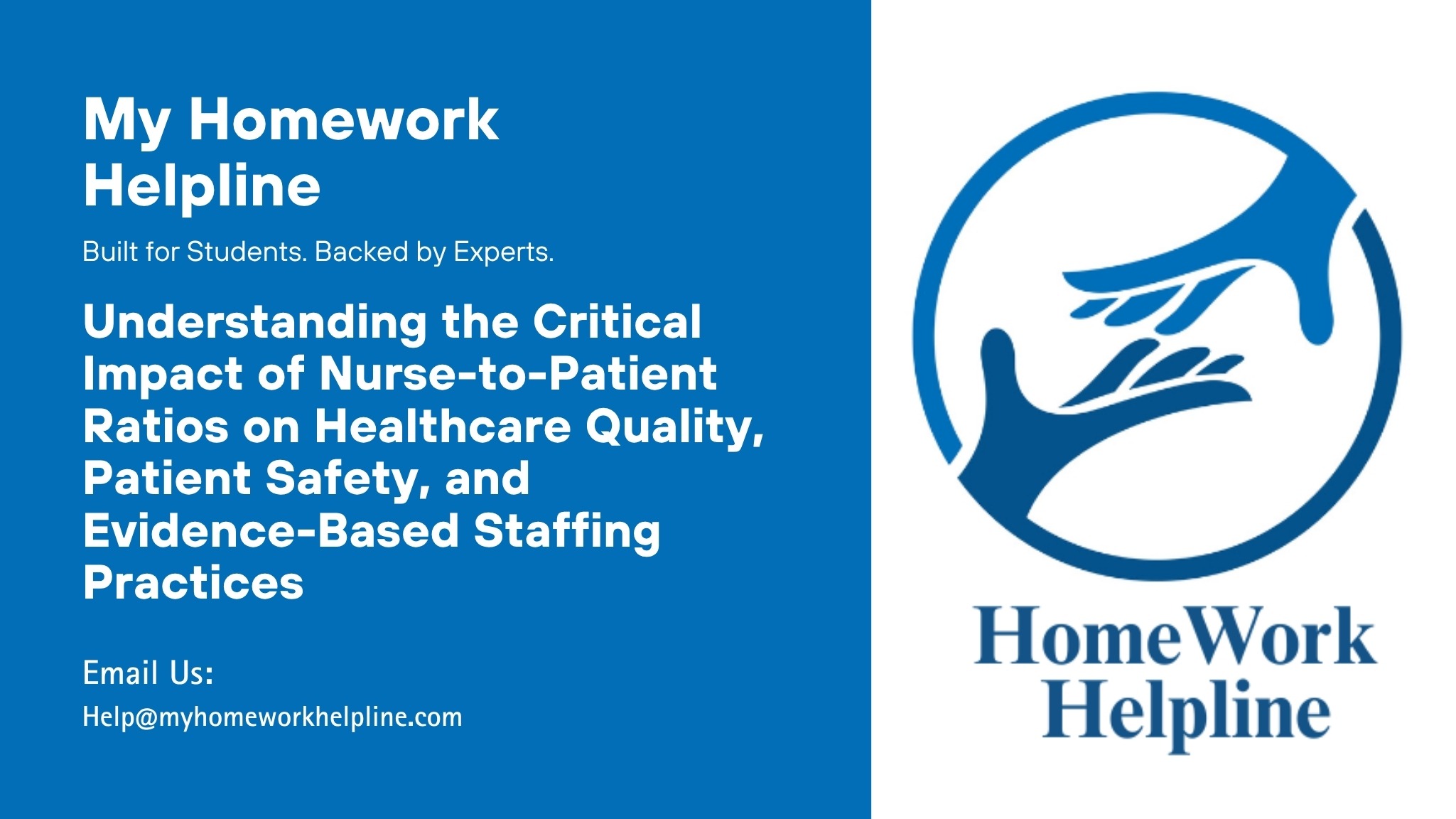How Nurse-to-Patient Ratios Affect Patient Safety and Healthcare Quality
The problem of low nurse-to-patient ratios has continuously continued to affect healthcare outcomes. The focus of our group will be understanding the effect of staffing ratios on the quality of health care and the safety of patients. Under-staffing of nurses leads to more workload for the nurses which in turn compromises the ability of nurses to deliver safe effective care for the patients. Research has consistently shown that high patient-to-nurse ratios often lead to adverse effects in patient care including increased patient mortality rates, increased medical errors and more patient re-admissions. According to the American Nurses Association, one more patient for a nurse increases mortality ( Dall’Ora et al., 2022 ).
For this investigation, the PICOT question is in adult patients that are hospitalized (P), how does adhering to the recommended staffing ratios (I) compared to not adhering to such ratios (C) affect patient safety outcomes (O) within six months (T)? The purpose of this investigation is to investigate the search strategies employed in identifying evidence to support the relationship between patient outcomes and staffing ratios. Studying the available literature will enable us to gain insights that will inform evidence-based interventions to improve staffing practices and enhance patient safety.
💬 Need help writing a detailed paper on healthcare staffing and patient safety? Place your order now at My Homework Helpline and ge
Levels of Evidence
The PICOT question is a therapy question seeking to evaluate how staffing interventions affect patient outcomes. Randomized controlled trials (RCTs) are the gold standard for answering such questions as they establish causality and are bias-free. Despite this, using RCTs in this domain poses ethical and logistical considerations calling for the use of case-control studies, cohort studies and cross-sectional analyses. These designs provide valuable insights into the associations between staffing ratios and health outcomes, allowing for the assessment of trends and patterns over time.
Search Strategy
For the identification of relevant articles for use, there was a systematic search of databases such as PubMed ProQuest and the Chamberlain University (CU) library. With search items such as “patient outcomes,” “nurse-to-patient ratio,” “safety,” and “quality of care.” This resulted in over 200 articles which were refined based on peer-reviewed materials published within the last five years. We also checked for full-text articles published in English as well that were relevant to the PICOT question. Based on the filters above we selected two articles. The first was a 2002 systematic review analyzing the impact of nurse-to-patient ratios on clinical and operational metrics across multiple healthcare systems and a 2012 cohort study examining the correlation between nurse staffing levels and patient safety outcomes in U.S. hospitals.
Description of Findings
The first article is a cross-sectional study from 161 hospitals in Pennsylvania. The study population was 7076 registered nurses. The research explores, outcomes such as the burnout of nurses, infections acquired from the hospital and the mortality of patients. The study found that a higher nurse-to-patient ratios were associated with increased levels of nurse burnout. The article indicates that lower staffing ratios resulted in a 30% increase in nurse stress and a 20% increase in the mortality of patients. Owing to these findings, the authors insisted on the need for sustainable efficient staffing practices and even demonstrated the importance of improved patient outcomes and reduced nurse turnover rates (Cimiotti et al., 2012).
The second article used a retrospective cohort design to investigate the relationship between adverse patient events and staffing ratios. This study provided an analysis of hospitals in the United States in a population of over 6 million patients discharged from about 799 hospitals. Key variables included nurse-to-patient ratios, length of stay in the hospital, and occurrence of medication errors. The findings revealed that hospitals adhering to recommended staffing levels experienced a 3% to 12% reduction in adverse events compared to those with higher ratios (Needleman et al., 2002). This led the authors to conclude that adequate staffing significantly improves the safety of patients and recommended policy interventions to mandate compliance with established guidelines.
When we compared the two studies, we saw that adequate staffing is very important in the promotion of the safety of patients. The cohort study provided specific data that is quantifiable on the outcome of the patients while the systematic review offered a wider perspective by integrating findings from different contexts. The demographic and procedural differences between the two studies improve the collective validity of the studies in offering an understanding of the issue that is comprehensive.
Implications for Practice
Findings from research provide concrete evidence that interventions aimed at improving staffing ratios should be supported. The research materials used were validated survey tools and hospital data systems ( Cimiotti et al., 2012). This ensured that the reports were accurate. Both studies show that it is necessity for for regulatory policies that facilitate the optimal staffing levels and stress on ongoing education for healthcare leaders on the implications of staffing decisions. Future research in this field should identify cost-effective strategies for implementing and maintaining evidence-based staffing standards. Two main questions arise. The first is based on the specific strategies that healthcare organizations use to comply with staffing guidelines and the second is based on leveraging technology for optimal staffing schedules to improve the safety of patients.
Conclusion
In conclusion, staffing ratios are an integral part of the determination of patient outcomes. Efficient staffing reduces the incidence of harm to patients, ensures that patients are safe and reduces burnout among nurses. The research highlights the importance of evidence-based policies and organizational commitment to sustaining optimal staffing levels. By addressing the systemic barriers to effective staffing, healthcare institutions can ensure better care for patients hence better outcomes. This paper has demonstrated the importance of incorporating research into healthcare practice.
References
Cimiotti JP, Aiken LH, Sloane DM, Wu ES. Nurse staffing, burnout, and health care-associated infection. Am J Infect Control. 2012 Aug;40(6):486-90. doi: 10.1016/j.ajic.2012.02.029. Erratum in: Am J Infect Control. 2012 Sep;40(7):680. PMID: 22854376; PMCID: PMC3509207.
Dall’Ora, C., Saville, C., Rubbo, B., Turner, L., Jones, J., & Griffiths, P. (2022). Nurse staffing levels and patient outcomes: A systematic review of longitudinal studies. International journal of nursing studies, 134, 104311. https://doi.org/10.1016/j.ijnurstu.2022.104311
Needleman, J., Buerhaus, P., Mattke, S., Stewart, M., & Zelevinsky, K. (2002). Nurse-staffing levels and the quality of care in hospitals. The New England Journal of Medicine, 346(22), 1715–1722. https://doi.org/10.1056/NEJMsa012247

